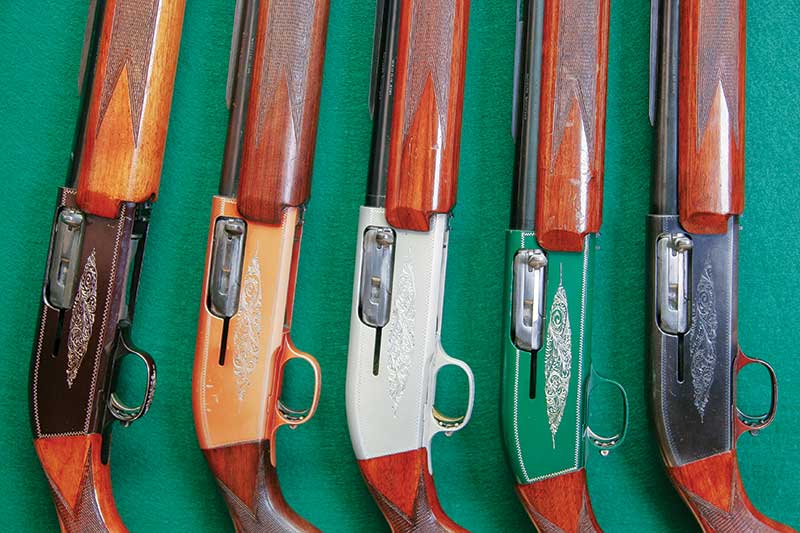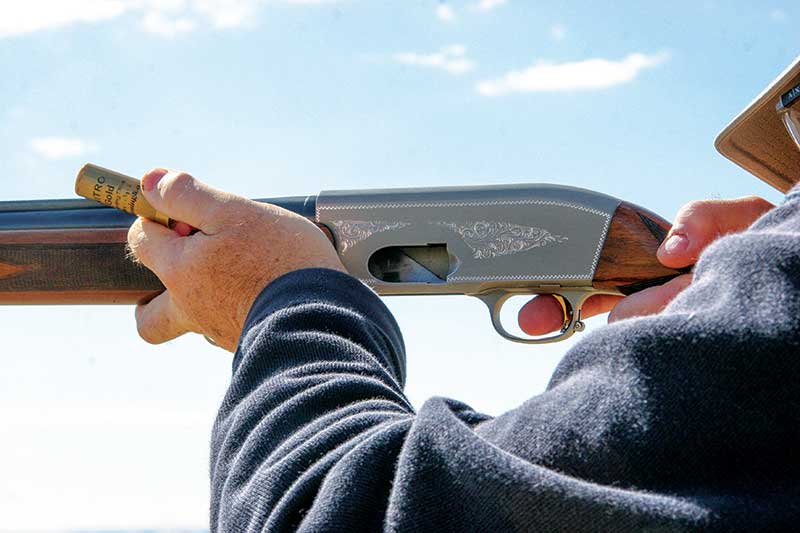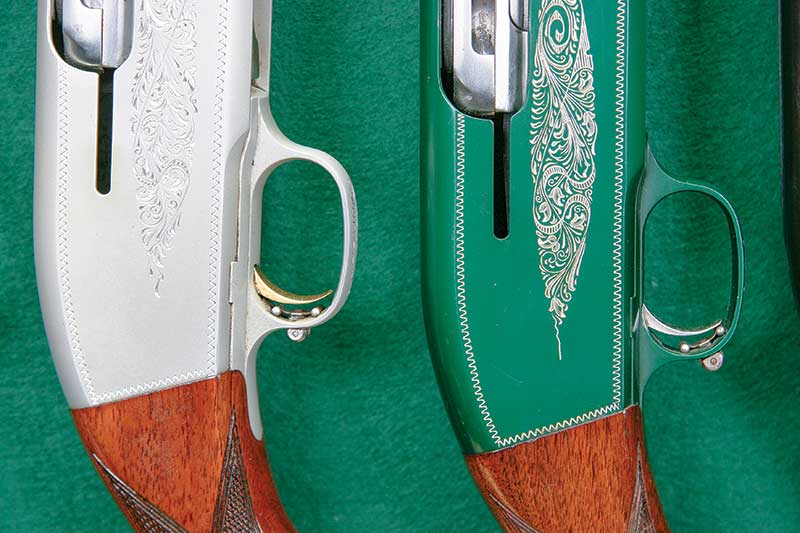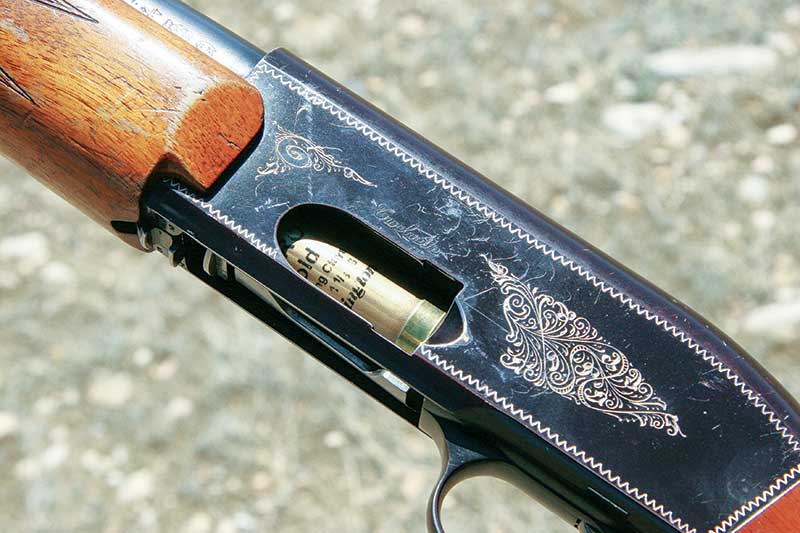Browning Double Automatic
An Ingenious Classic

Left to right: The “Twelvette” came in Dragon Black, Autumn Brown, Velvet Gray and
Forest Green while the Standard (Steel) model came in traditional blue. The Double Automatic
has the distinction of being the shortest action of all semi-autos and has no pins or buttons
visible, giving it a “sleek” appearance.
As a youth perusing outdoor magazines, the Browning advertisement for the “Double Automatic Shotgun” really captured my attention. Compared to the Auto 5, the Double Auto was svelte and as a two-shooter was intriguing. They were, and are, the enigma of the shotgun realm and certainly one of the grandest autoloaders to ever grace the field or range. Ironically they were not a commercial success and almost 50 years after their discontinuation they are still under-appreciated.
Second Generation Genius
The Browning Double Automatic was the creation of Val Browning, John Moses’ talented and under-acknowledged son. The Double Automatic was Val’s baby alone and when he passed away in 1994, and even though he had accumulated 48 patents of his own, he is still firmly ensconced in his father’s shadow.
From 1920-1935 Val oversaw the production of Browning firearms being made by Fabrique Nationale Herstal. Foremost among these products was the popular A5 shotgun, a long-recoil-operated shotgun in which barrel and bolt remain locked together and move approximately 3″ to the rear upon firing. They provide a two-impulse recoil which old timers often referred to as a “double shuffle.” This dual-impact-recoil is exacerbated if the friction ring is not set appropriately. Remington and Savage both made clones of the A5 and the original Browning design was pretty much the only operating system for semi-automatic shotguns for the first half of the 20th Century.
Then, in 1952 Val Browning received a patent for a “speed loading” mechanism he integrated into his new shotgun and started production of the radically designed Browning Double Auto. Since the barrel only moved about 1/2″ it was christened a “short-recoil-action” shotgun. Eliminating the “double shuffle” effect of the A5, his new design considerably reduced the felt recoil of the 12-gauge cartridge.
First Failure
Initially Val took his new gun to the European market where it was a dismal failure, so much so many “histories” of the Browning Double Auto claim production didn’t start until 1955, the year he introduced it to the American market. Whether the Serial number records reflect the exact number of guns produced or not, between 1952 and 1958 the numbers were assigned at a rate of 3,600 per year. Assuming the production numbers were contiguous, 10,800 guns were produced prior to their offering in America in 1955.
Perhaps it was the prestigious Browning name or the noticeable decrease in felt recoil, but for whatever reason the American market seemed more receptive than the Europeans, even though the gun only fired two shots and not the five of the A5 or Remington offerings. Historians and writers have speculated perhaps Val was anticipating conservation efforts would eventually restrict the magazine capacity of all hunting guns, plus there were no target games requiring more than two shots. Quien sabe? A look at contemporary production guns shows the trend toward low capacity didn’t catch on.
Simultaneously the death knell for the short-recoil-action was being refined by High Standard and Remington. In 1953 High Standard brought to market the first gas operated shotgun marketed thru Sears as the J.C. Higgins Model 60. In 1956 Remington brought out their first gas-gun, the Model 58 and in 1963 they captured and dominated the semi-auto market with the 1100, still in production today!
Positive Traits
While the proliferation of gas and inertia operated shotguns have made the short-recoil-action archaic, Val Browning’s pride and joy still has a lot going for it. It is unique mechanically and ergonomically.
It has the shortest action of any semi-auto ever made. The Double Auto’s action measures 6-5/8″ from front to rear compared to 8″ for the Beretta 391. Even the small, scaled-frame Remington 11/48 28-gauge measures 7-3/4″! The short frame keeps the bulk of the weight between the hands, generally making a gun swing better.
Another unique feature of the Double Auto is it has no magazine. The second round sits on the shell carrier and is visible in the open loading port on the left side of the receiver. You can tell at a glance if the gun is fully charged.
The lack of a magazine does away with the fore end cap. This “sleeks” the appearance of the gun and until the currently produced Browning Maxus, the Double Auto was the only autoloading shotgun ever produced without a fore end cap.
The Browning Double Auto is the only repeating shotgun with no visible pins or buttons on the action. This enhances its appearance. Two internal pins run parallel with the action and hold the trigger housing in place. Removing the trigger group requires taking the butt stock off the gun to gain access to these pins.
Positive Traits
While the proliferation of gas and inertia operated shotguns have made the short-recoil-action archaic, Val Browning’s pride and joy still has a lot going for it. It is unique mechanically and ergonomically.
It has the shortest action of any semi-auto ever made. The Double Auto’s action measures 6-5/8″ from front to rear compared to 8″ for the Beretta 391. Even the small, scaled-frame Remington 11/48 28-gauge measures 7-3/4″! The short frame keeps the bulk of the weight between the hands, generally making a gun swing better.
Another unique feature of the Double Auto is it has no magazine. The second round sits on the shell carrier and is visible in the open loading port on the left side of the receiver. You can tell at a glance if the gun is fully charged.
The lack of a magazine does away with the fore end cap. This “sleeks” the appearance of the gun and until the currently produced Browning Maxus, the Double Auto was the only autoloading shotgun ever produced without a fore end cap.
The Browning Double Auto is the only repeating shotgun with no visible pins or buttons on the action. This enhances its appearance. Two internal pins run parallel with the action and hold the trigger housing in place. Removing the trigger group requires taking the butt stock off the gun to gain access to these pins.
Speed Load
The Double Auto is the fastest shotgun to load in existence. When the bolt is locked to the rear, the gun is loaded by simply inserting a cartridge into the loading port. This automatically activates the shell holder and feeds the round into the chamber. A second round can then be placed in the port on the shell holder. For a right-handed shooter, this can be accomplished while holding the gun by the pistol grip. To drop the bolt on an empty chamber for storage, there is a carrier latch at the bottom-front of the action that can be pushed forward to release the bolt.
The gun also has a unique, ambidextrous safety. Early A5s had a sliding lever protruding down in front of the trigger located inside the trigger guard. While ambidextrous and quick, it was distinctly hazardous, particularly if the shooter was wearing gloves or just had thick fingers. Subsequent “improvements” to the A5 replaced the safety with a traditional cross-bolt button. Val improved upon his father’s design by placing a vertically sliding block behind the trigger, mounted on the backside of the trigger guard. The safety can be deactivated with either hand without requiring the trigger finger to be placed inside the trigger guard
Types
The Double Auto was made in three versions. The initial model was manufactured with a steel receiver. These are referred to as the “Standard” Model and were manufactured from 1952–1960. A “Lightweight” model was manufactured from 1952–1956 at which point it was rechristened and marked “Twelvette.” In 1957 an even lighter model, the “Twentyweight,” was introduced. Both the Twelvette and Twentyweight have aluminum-alloy receivers with various names such as “Duralumin” and “Hiduminium.”
According to Ned Schwing, there were 65,000 Twelvettes manufactured. If one believes the rather murky estimate of a total of 67,000 Double Automatics being manufactured, it doesn’t allow for the existence of many Standards or Twentyweights.
The steel version was offered only in traditional blue and the Twentyweight came in an anodized black with gold-filled engraving. The Twelvettes on the other hand were offered in a variety of colors. According to Browning lore, Val made up a number of different colors as sample guns and sent them out to his two biggest dealers — Sears and Montgomery Ward — to see what the public thought. Some of the dealers sent them back claiming no one wanted to hunt with anything but a blued gun. Val ordered the returned guns destroyed but a few survived.
Pink Double?
Val then asked his employees what colors they thought would be most popular with the public. Their input resulted in four “official” colors being offered: Dragon Black, Velvet Gray, Forest Green and Autumn Brown. From a collecting standpoint, Black and Silver are readily available while Green and Brown are rarely encountered. Royal Blue, Oxblood Red, Golden Yellow and even Pink are extremely rare versions escaping factory destruction or were never returned by Sears and Wards.
Barrels for the Double Auto were available in 26″, 28″ and 30″, with the Twentyweight having a 26-1/2″ tube. The lightest Standard model runs 7 lbs. 6 oz., the Twelvette is 6 lbs. 12 oz. while a Twentweight is a meager 6 lbs. even. They are a pleasure to carry afield.
The Double Auto is the only gun Browning ever produced with a unique “recessed” rib. This is a solid, non-ventilated rib with a deep channel cut down its length to reduce weight. Traditional ventilated ribs were also available.
Take It For A Spin
Perhaps the Double Automatic’s preeminent asset is its handling dynamics — the shotgun is neither “whippy” nor “sluggish.” With the Browning Double Automatic, the stars seemed to perfectly align concerning overall weight and how it’s distributed.
If engraved metal, hand fitted parts and checkered wood brings a gleam to your eye and quickens your pulse, you’ll find the Browning Double Automatic a gratifying acquisition. The challenge is you’ll be hard pressed to buy only one.








